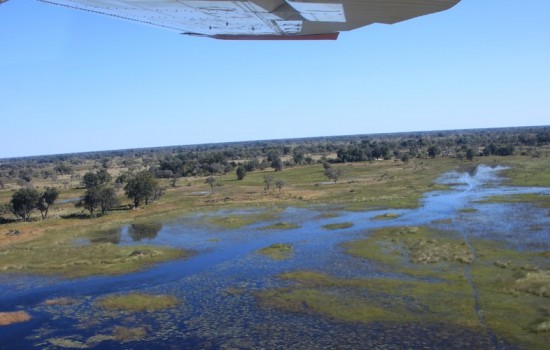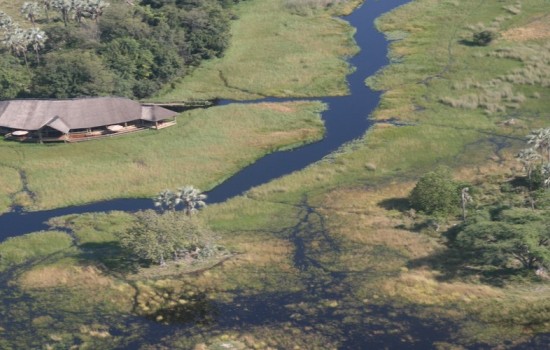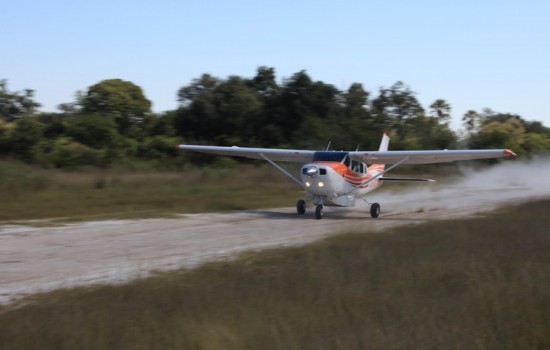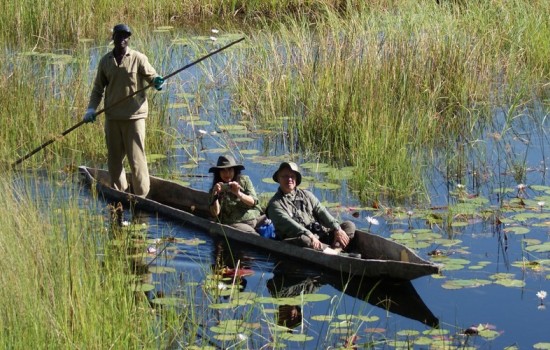Okavango Delta


The perennial Okavango River runs southward into its delta across the Caprivi Strip from the highlands of Angola. Most of its water evaporates from the delta wetlands. The Okavango Delta, in the midst of the Kalahari Basin, is Africa’s largest and most beautiful oasis. It’s a natural refuge and giant water hole for the larger animals of the Kalahari. The Okavango River is best described as “the river which never finds the sea”.
The Okavango Delta (or Okavango Swamp), in Botswana, is the world’s largest inland delta. The area was once part of Lake Makgadikgadi, an ancient lake that mostly dried up by the early Holocene, except for seasonal flooding. Today, the Kavango River has no outlet to the sea and instead, it empties onto the sands of the Kalahari Desert, irrigating 15,000 km² of the desert. Each year on average some 11 cubic kilometers of water reach the delta. Some of this water reaches further south to Lake Ngami.

The waters of the Okavango Delta are subject to seasonal flooding, which begins about mid-summer in the north and six months later in the south (May/June). The water from the delta is evaporated relatively rapidly by the high temperatures, resulting in a cycle of cresting and dropping water in the south. Islands can disappear completely during the peak flood, then reappear at the end of the season. This process of evaporation was badly understood as late as the early 20th century: The water entering the delta is unusually pure. This is mainly due to the lack of agriculture and industry along the Kavango River. It passes through the sand aquifers of the numerous delta islands and also evaporates thus leaving enormous quantities of salt behind. Where this happens these processes are so strong that the vegetation disappears in the center of the islands and thick salt crusts are formed.
Wildlife
The Okavango is home to a prosperity of wildlife and attracts thousands of visitors a year. There are many different ways to visit this beautiful region and accommodation ranges from simple camps up to luxury resorts within the delta region.


The delta provides a seasonal habitat to numerous different species. Among these are African Bush Elephants, the African Buffalo, the Hippopotamus, the Lechwe, the Topi, the Blue Wildebeest, the Giraffe, the Nile crocodile, the Lion, the Cheetah, the Leopard, Brown and Spotted Hyenas, Kudu, the Sable Antelope, both the Black and the White Rhinoceros, the Plains Zebras, the Warthog and the Chacma Baboon. Notably the endangered African Wild Dog is present within the Okavango Delta, exhibiting one of the richest pack densities in Africa. The delta also includes over 400 species of birds, including the African Fish Eagle, the Crested Crane, the Lilac-breasted Roller, the Hammerkop, Ostrich, and the Sacred Ibis.

To visit the Okavango Delta the best starting point is the town of Maun. Basically you have three different options to experience the beautiful Okavango varying in length from one day to several weeks. Below you will find the 3 most used options.
1) Day visit: the day tour always begins and ends in Maun. As a rule you will be collected at your accommodation at about 07:30 in the morning and transferred in a 4×4 vehicle to a mokoro station* mostly in the general area of Ditshipi. Here you will be introduced to your professional guide who will take you by mokoro into this unique wilderness. You will travel via various papyrus edged canals and lakes to an island where you will go on a bush walk or foot safari. During the walk you will be offered a basic lunch. Mid afternoon you will return to the mokoro station where your transfer vehicle awaits to bring you back to your accommodation.
2) More day Mokoro Safari: minimum travel time is 1 night and 2 days (we recommend 2 nights and 3 days)
As above you will be collected at your accommodation and transferred to a mokoro station. Here you will be introduced to your guide who will take you by mokoro to an island where your camp for the next day/s has already been set up. From this point you will undertake several walking and mokoro safaris with enough time to relax and experience the Okavango. All food and basic drinks are included and catered for so all you have to do in the evenings is to relax and enjoy the beautiful African night sky and sounds. On the day of your departure you will be transferred back to your vehicle or accommodation and have some time to explore Maun or go on a scenic flight over the delta (it is advisable to book ahead for the flight)
*Mokoro station is a place where mokoro’s are kept ready for use. Mokoro’s are traditionally carved from trees and has been used for millenia in the delta as transport. To save the environment more mokoro’s are being made from fibre glass these days.
3) Luxury Delta Safari including private charter flight and lodge: minimum travel time: 2 nights 3 days. After arriving at your accommodation in Maun you can relax or explore the town. Your flight details will be sent to the accommodation. After breakfast the next morning you will depart to Maun Airport to meet up for your private charter flight. On average your flight into the delta will take between 20 and 40 minutes and after arrival at the lodges private airstrip you will usually be taken to the lodge by water. At the lodge you will be welcomed and informed of the day schedules and possible activities. On these fly in safaris all activities, meals and most drinks are included and often (depending on which lodge you visit) you will have a private guide who will also assist you during your stay. You will be informed the day or evening before departure when your flight out of the delta is scheduled.


